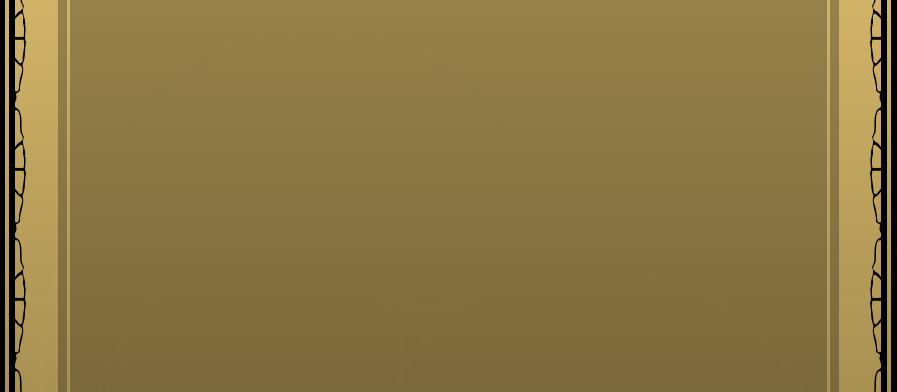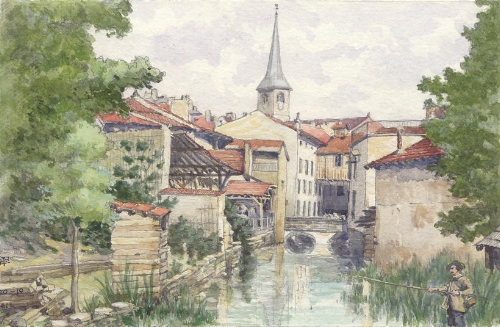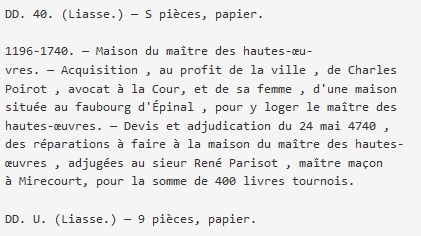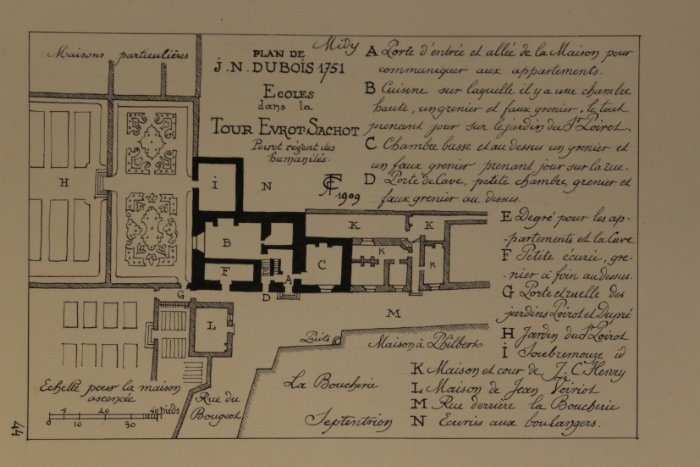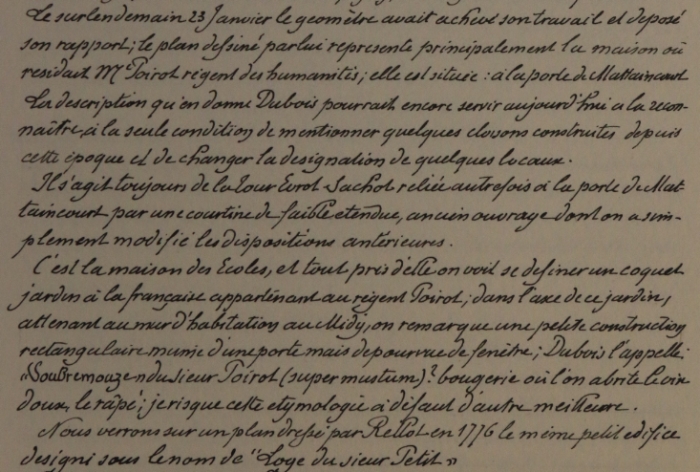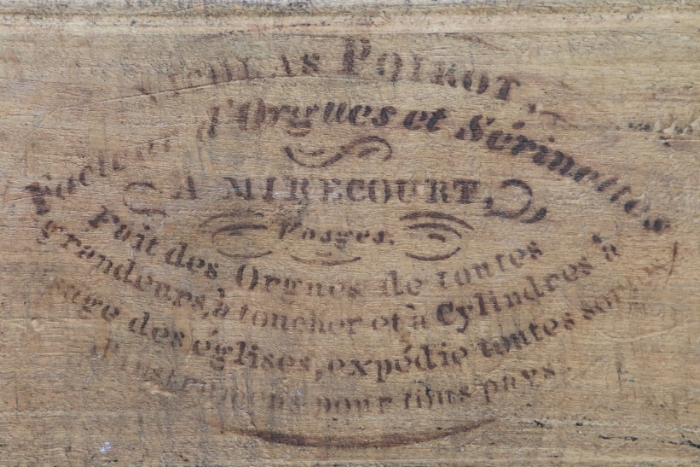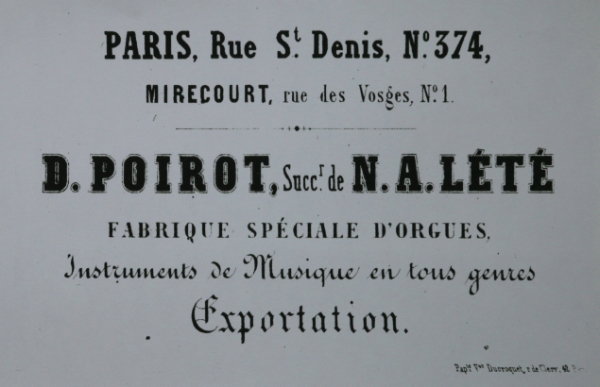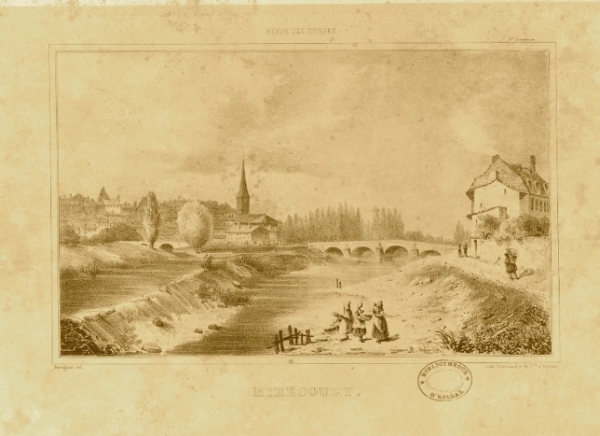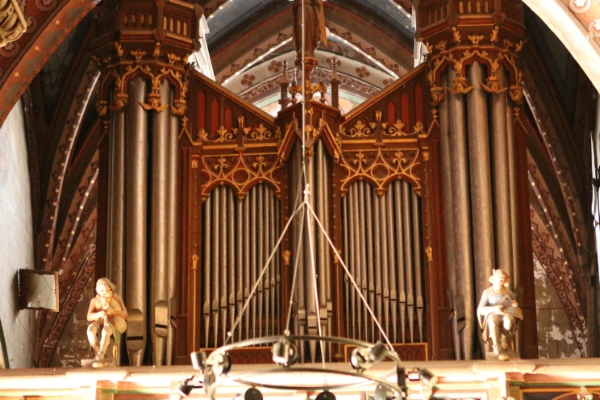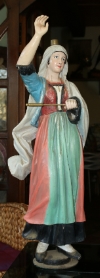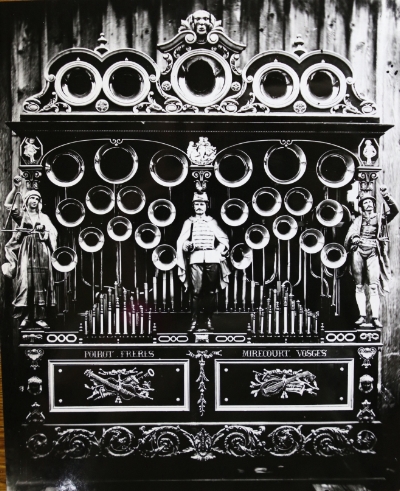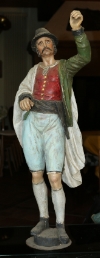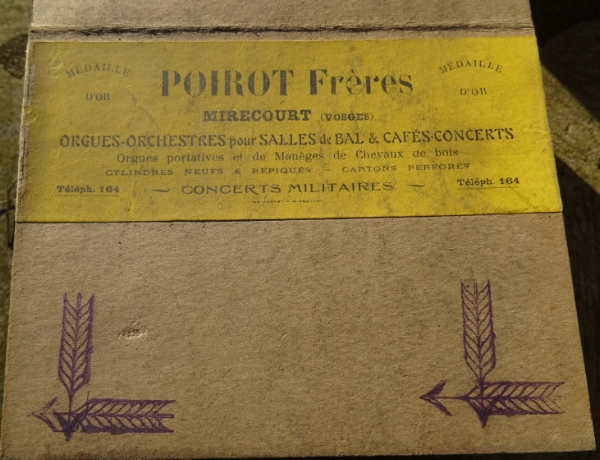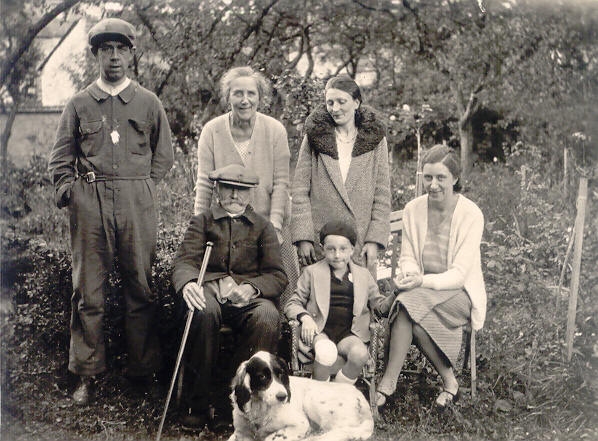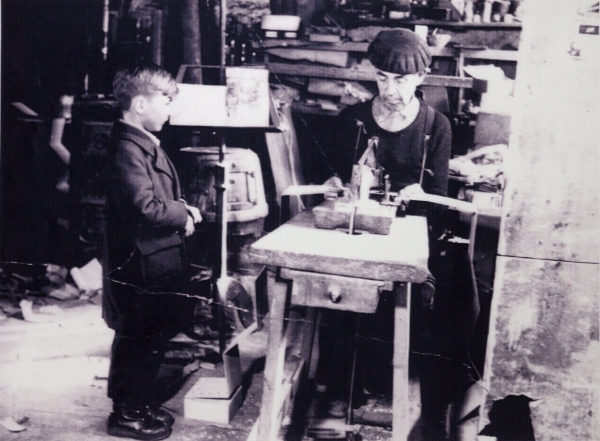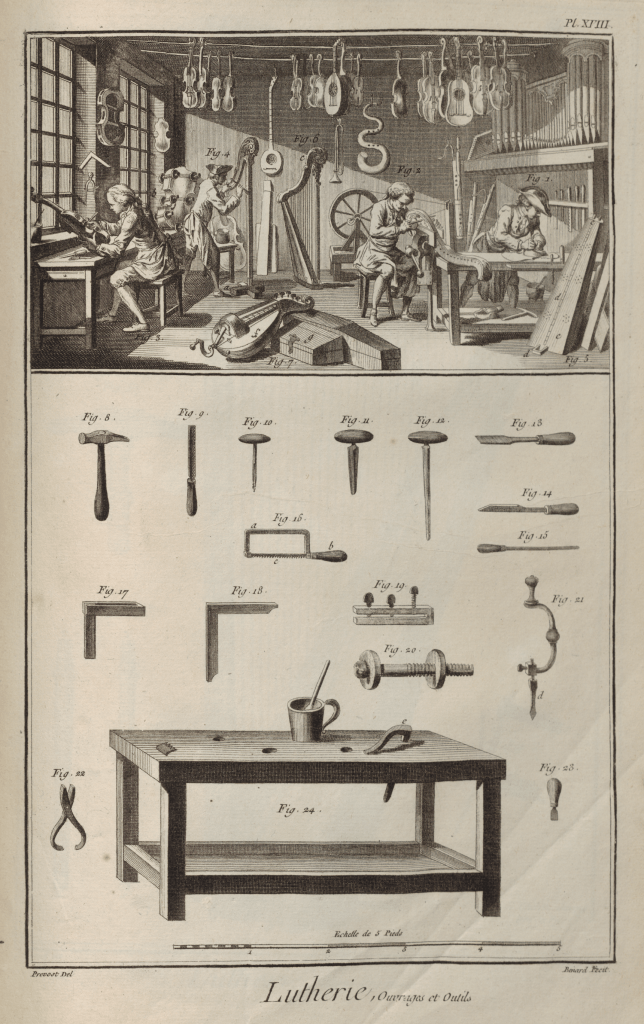|
Aquarelle de François Clasquin - "Mirecourt Temps passés - Temps présents". The Poirot family has been established in Mirecourt for more than three hundred years, the oldest known ancestor to date is Nicolas Poirot, born around 1630. His son, Charles Pierre Poirot was born around 1686 and was also a lawyer at the Court. He married Françoise Poncet on 9 January 1712 and died on 27 July 1759 at the age of 73. Charles and Françoise have a son also named Charles who was born on May 12, 1717. Below n excerpt from his birth certificate dated September 23, 1741.
Charles will be like his father and grandfather, a lawyer at the Court of the Royal Bailiwick of Mirecourt. In the inventory of the Departmental Archives prior to 1790 (ML Duhamel), one can read about the lawyer at the Court Charles Poirot:
Digitisation by Google often presents typographical errors as shown by the date of "24 May" and is confusing. Indeed, Charles Poirot married Marie Jeanne Bailli on September 3, 1743 as specified in their marriage certificate (AD des Vosges). Charles is also Regent of the Humanities. As such it will be housed in the Evrot Sachot tower on rue du Bougeot as specified in the 1751 plan by JB Dubois (AD Meurthe and Moselle B-11-815).
From this union Nicolas Poirot was born on September 9, 1749. Nicolas, merchant, is also a lawyer at the Court. He married Marie Françoise Denis on January 24, 1769. Nicolas and Marie Françoise gave birth to the first organ builder of the family, Nicolas Poirot, who was born on August 31, 1771.
Nicolas Poirot (31st August 1771 - 4th June 1821) On August 31, 1771 the first organ builder of the Poirot line was born. Nicolas married a lacemaker, Jeanne Nicolas in 1805 in Mirecourt. Jeanne is the younger sister of Didier Nicolas, renowned luthier of Mirecourt as attested by the following documents: Emperor Napoleon 1st presenting the medal A report of the technological exhibition of 1884, mentioning the awarding of a bronze medal to Poirot-Frères (grandson of Nicolas), refers to the founding of the Poirot house in 1806. And according to the Annuaire français de la facture instrumentale, de l'édition musicale et des des industries qui s'y rattachent, First year 1913, Edited by Musique et instruments, below, the Poirot House was founded in 1812.
Source: http://jeanluc.matte.free.fr/articles/typologie/1913/1913.htm
Nicolas signs his fabrications using a stamp that can be found on the bellows or under the barrel carriage of some organs. This one precise: " Nicolas Poirot, facteur d'Orgues et Sérinettes à Mirecourt - Vosges - Fait des orgues de toutes grandeurs, à toucher et à cylindres à usage des églises, expédie toute sorte d'instruments pour tous pays " which means " Nicolas Poirot, organ builder and Sérinettes in Mirecourt - Vosges - Mades organs of any sizes, keys and barrels for use of churches, send any kind of instruments for any countries
It is amusing to note the publication of the advertisement below 3 years after his death. Those lucky enough to have his instruments today are still "happy with his accuracy and his work"! From "L'ami de la religion et du Roi", Journal ecclésiastique, politique et littéraire. Page 96, Volume 41, 1824.
Jeanne and Nicolas have 3 children including Didier Poirot.
Didier Poirot (16th July 1806 - 1st June 1894) Born in 1806 in Mirecourt, Didier Poirot followed in the footsteps of his father Nicolas as a serinettes and barrel organ builder. After living in Mirecourt, he moved to Paris in 1834, 374 rue Saint Denis and worked at Nicolas Antoine Lété's worshop. When Lété returned to Mirecourt to create an organ factory, he chose Didier to hold the store in Paris. When Lété moved to Mirecourt as he retires, Didier bought his Parisian workshop on 29 April 1838 for 5400 francs. The act of this transaction shows the presence of 22 organs, 29 serinettes, 90 guitars, 143 violins and 3 basses as well as accessories such as strings, easels, cases. (Source Les luthiers parisiens au 19ème et 20ème siècle : Jean-Baptiste Vuillaume et sa famille Ed. Amis de la Musique, 2006 – Sylvie Milliot).
Didier obtains in 1844 a bronze medal at the Industrial Exhibition of Paris.
From : Rapport du Jury Central sur les
produits de l’industrie fançaise en 1844.
Below is an excerpt from the Scientific and Industrial Review of 1844, more particularly the chapter devoted to Technical Studies on the Exhibition of French Industry Products in 1844 by N. Baquillon, librarian of the Conservatory of Arts and Crafts. There is mention of the same chapel organ made by Didier, playing on the crank but also on the keyboard.
We find mention of this medal also below in the Revue et Gazette Musicale n° 31 of August 4, 1844.
In addition to his Parisian activity, Didier opened a workshop in Mirecourt in 1846. Adèle is the daughter of the violin maker Louis-Joseph Paquin dit Saint-Germain, known in violin making as Joseph Germain, and sister of the violin maker Emile Germain (a register of Emile's orders and customers is visible in the Bonetat collection in the Vosges departmental archives). Adèle and Didier gave birth to 8 children. From left to right: Didier Poirot, Auguste-Gabriel on his knees, Georges, Jeanne-Marthe, Victor, Auguste-Didier on the knees of his mother Adele.
Didier then repatriates his workshops in Mirecourt at 1, avenue des Vosges (current avenue Duchêne), while keeping his store in Paris (374, rue Saint-Denis). Before February 1848, Didier had twelve workers, who went to six in 1849, then again twelve in the workshop and as much in town in 1855. With a difficult character, his anger was famous: a worker was running to the apartment, "Madam, sir is angry!" The sweet Adele was coming down and her hands wisely crossed on her black silk crinoline exclaimed: "you make my teeth ache, my friend !" and the anger was falling ... At the same time, Didier employs luthiers (Charles Lotte and Hypolite Charotte, father-in-law of his son Georges) whose productions he sells. He exports to America and Mauritius, where his wife's uncle lives, as well as in Australia, as this small advertisement published on December 4, 1886, in the Sydney Evening News suggests. http://nla.gov.au/nla.news-page11926298" target=" "MUSICAL NOTICE.— To Showmen, & c— For SALE, a Barrel ORGAN, by D. Poirot, Paris, containing brass trumpets, metal pipes, drum, and bells, plays 27 airs, marches, quadrilles, waltzes, &c, 4 stops, very powerful and effective, in splendid order, price £18, a gift, cost £50. Address 29, Botany st, S. Hills."
Didier also sells wine, just like many Mirecourt's instrument dealers, where wine is used as a bargaining chip. In 1862 he exhibited double basses, cellos, viola, violins and hand-cranked
organs at the London World's Fair. The following excerpt from French section. Official Catalog - International Exhibition 1862 also states that 80% of its 1862 production is exported.
There are still some announcements in the General Directory of Trade and Industry, or almanac of the 500 000 addresses of 1855 (p666 and p670), as well as 1862, p971 Then 1865, it is the bankruptcy, driven by the fall and the dissolution of the Thibouville Company, its principal debtor. Bankruptcy deemed excusable by the Commercial Court (Series 7U42 AD of the Vosges) will prevent incarceration but he loses the right to sign his instruments which will now bear the mark "F.D.POIROT", FD for Femme Didier Poirot. In 1867, he then installed his workshops Quai du Vieux Cemetery and comes to live there. Below is an engraving by JB Ravignat (1803-1875) probably made between 1831 and 1839 when the author stayed in Remiremont, representing a view of Mirecourt and the hunting relay of the Dukes of Lorraine where Didier would settle a few years later.
The Poirot house on the Quai du Vieux Cimetière, which later became Quai François Clasquin. The family's house in 2001 (Photo J-M Moitrot) The house was demolished in 2004. Photo taken by B. Poirot in February 2006.
Didier build very few church-organs: the only known ones are the organ from Uxegney (probably build in 1870, according to the family memory) and in Saint-Julien-les-Villas (departement of Aube) build in 1872.
Didier's sons went all to Nancy to study music and architecture as the organ plans had to be perfect. At Didier's death in 1894 the workshop was taken over by his sons under the name Poirot-Frères. It is then the golden age of the factory which had the reputation to manufacture the most "beautiful organ of the world" according to Alain Vian, antique dealer in musical instruments and brother of Boris.
Source: Archives Départementales des Vosges, 240J23-2. Photo probably from F. Clasquin Didier's family 2nd raw: 3ème rang: uncertain. The 5 brothers taking over the succession of Didier under the name of
Poirot-Frères are all on this picture.
This photo probably dates from 1876, a few months before the death of Adele..
Victor Poirot (11th November 1850 - 24th December 1934)
Comment from Bertrand Poirot: The date of birth mentioned here is incorrect. George was born April 24, 1849. Moreover, after reviewing several photos, it appears that it is rather Auguste Marie Gabriel (1856-1897), his brother, who is represented here.
Poirot Frères represented by Georges, Victor, Gabriel and Didier exhibit several organs at the Melun exhibition in 1880 and at the 1884 technological exhibition held at the Palais de l'Industrie where the jury awarded them a bronze medal. Below is an example of their production. The musicians on both sides were found fortuitously at the Chartres auction house!
Then Poirot Frères, who were only two at that time as Georges and Didier died, presented barrel organs at the Universal Exhibition of Paris in 1889. http://www.irpmf.cnrs.fr/IMG/pdf/Exponationale1978_1900.pdf
Source: Archives Départementales des Vosges, 240J20
But Victor quickly found himself alone at the head of the house Poirot-Frères after the successive deaths of his brothers. The numerous customers, mainly fairground stallholders, asked for carrousel organs. Victor also builds salon organs. He refused nevertheless to make organs playing cardboards.
Drawing of a 72 keys fairground organ: Source: Archives Départementales des Vosges, 240J37
Source: Archives Départementales des Vosges, 240J37
Below an excerpt from the Poirot mail register (August 1880):
Transcript of the text: Victor also exports organs to Cuba as evidenced by the mail below to Francisco Borbolla - dated July 28, 1904 - who expressed his wishes for the order in progress. Source: Archives Départementales des Vosges, 240J6
Translation on the back of the mail.
Francisco's youngest son, Carlos, was also sent to France to study. The Borbolla family made organs and adapted their sounds to Cuban music. Mention of these exchanges can be found in the "History on the organs of Manzanille" written by Carlos himself. Poirot-Frères also export to Algeria as specified by the following advertisement. Source: Archives Départementales des Vosges, 240J36
His business is prosperous until 1914 and employs up to 25 workmen. Victor Poirot, his wife Marie
Eugénie Poirot born Gros (on th right) and their 3 chidren Georges, Gabriel and
Elisabeth (sitting all three on the ground). Victor died on 24 December 1934, the day of the funeral of his wife Marie, who died on 21 December. Georges Poirot (19th November 1896 - 16th January 1954) Victor's eldest son, Georges "was a truculent and nonconformist character, with a loud voice and easy insult," says his niece Evelyne Bonetat in the bulletin of the Friends of Old Mirecourt - Regain. "He did not like priests or flea paws" according to his expression for nuns. "Socialist at the Jaurès, he wore the red flag in the city, he had a lot of empathy for the poor and marginalized or gypsies. Refused to the board of revision in 1914 for constitution too frail, his father prevents him from engaging. At the end of First World War, George goes to the fair
of Nancy. There, he hears himself saying: "The house Poirot? It does not
exist anymore!"
At the price of hard work, he managed to build up a fair clientele but also provides his father's old clientele located in Cuba, Chile, Argentina and Reunion Island.
Standing left, Georges Poirot with his mother Marie Eugènie who is behind Victor Poirot, my grandmother Germaine on his left and Elisabeth sister of Georges, sitting on the right - February 1931
In 1932 Georges hired Camille Tourel as a writer and Charles Ceurin as a cabinetmaker. Fishing contest for "Hardened Singles" in Haroué around 1926. Charles Bazin is the 2nd bottom left from the left. Among the other luthiers who participate in this fishing game, we recognize at the top of the group from the left: Pierre Claudot (1), Camille Tourel (2), Albert Claudot (4). Fonds Pierre Claudot Archives - Source: http://phonotheque.hypotheses.org/7797#sthash.LThjVwIn.dpuf Jean-Marie Moitrot, who knew Camille Tourel well, reports: "He was the chief of the municipal music of
Mirecourt. He told me that the arrangements of his predecessors were ancient
and solemn and he changed completely. He was imaginative and fancy and his
cards are frankly. With his talent, he concealed very well the semitones
missing (from the 49 keys for example) and the listener did not notice the
trickery. Excerpt from a Georges register: note concerning billing at Limonaire Frères
From 1932 to 1939, the "House Poirot-Frères, Georges Poirot successor" is assailed by orders. It was necessary to work at night and Sundays to honor the requests. With the Second World War, fairgrounds are rare and the production is stopped. "
Georges worked during the war at the Eastern
Electricity Company and served the military hospital and the visiting troops as
a scout.
Jean Marie Moitrot:
But that will not prevent him from having a courageous conduct during the war: thus at Epinal, during the bombing of the station where there were many dead and wounded and from which all the volunteers of the Red Cross were gone ... Who was there under the grape? Georges with the priest! The fairgrounds resume from the liberation and it takes a significant amount of cartons because there were plenty of new songs. Post-war music adapts very well to organs.
His niece continues as follows:
In 1947, Georges had to face the floods which drowned the workshop established on the banks of the Madon. It had rained days and days and my uncle moved the premises. People had come to help him spontaneously. He did not go to bed for 4 days. The local was full of instruments, patraques as he said, that the fairgrounds put in sale deposit."
The development of the pickup will sound the decline
and the end of the organ builders. Making cartons alone is not profitable and Georges cannot pay Camille Tourel anymore. In 1952, he had to lay off. Georges will do all the work alone until his death.
Georges in his factory, 1952
Alain Vian, who has been a shopkeeper at No. 8 rue Grégoire de Tours in Paris since 1946 for the rescue of these instruments from another time, bought in 1957 the entire business of Georges (documents, tools, musical insturments). * Alain Vian was the brother of the well known Boris Vian: writer, poet, songwriter, singer, critic and composer of jazz ( trumpet ).
Tomb of the Poirot family in Mirecourt
The history of Poirot organ builders ends thus, 150 years after the foundation of the Poirot House by Nicolas Poirot The Poirot workshop in the garden of the family’s house in Mirecourt (1929)
A workbench of the Poirot workshop
Which can be found on this plate from Diderot and D'Alembert's "Encyclopedia" published between 1751 and 1772
Sources : E. Bonetat, Jean-Marie Moitrot (via Dominique Debut), Internet Pictures of the family archives and B. Poirot Formatted and completed by Bertrand Poirot.
|

| Story of the family |
 |

